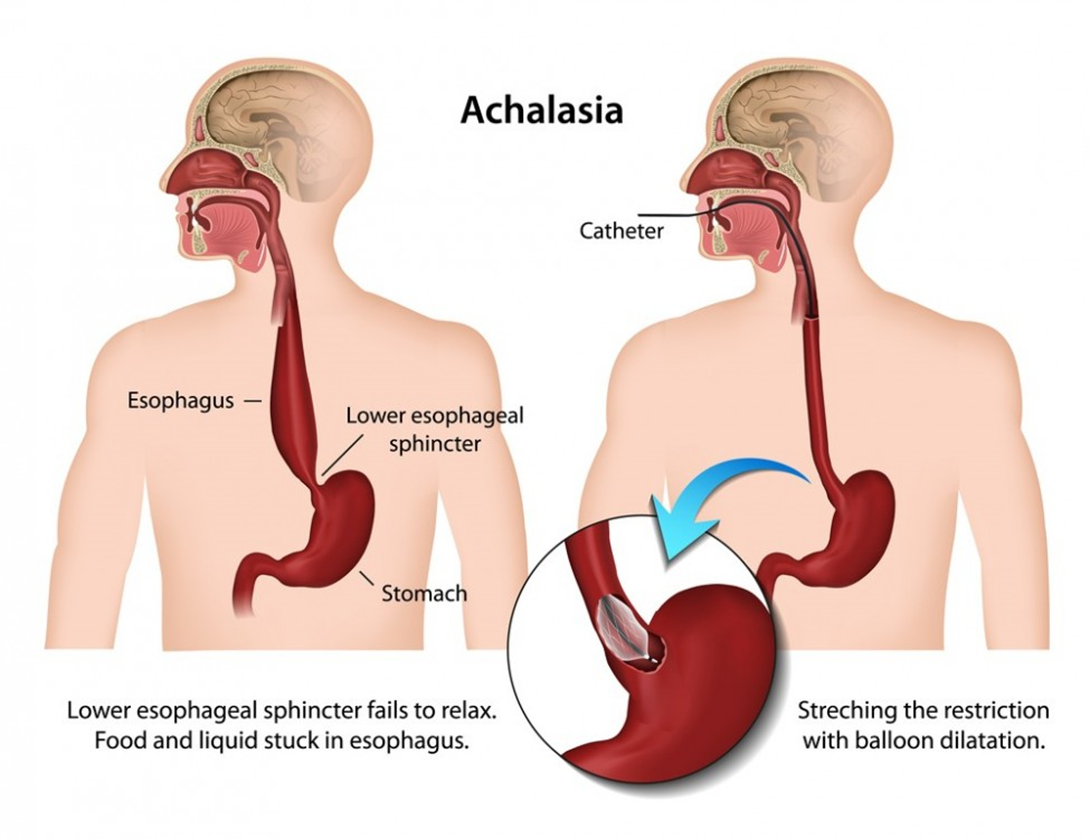A nurse is caring for a client who has oral achalasia. The nurse should ask the client which of the following questions to assess their ability to swallow?
"Do you feel like you have food stuck at the base of your throat?"
"Do you feel any burning sensations in your throat?"
"Do you have any feelings of fullness in the neck?"
"Do you have any problems with pain while swallowing?"
The Correct Answer is A
Choice A reason: Asking if the client feels like they have food stuck at the base of their throat is a pertinent question for assessing swallowing in a client with oral achalasia. Achalasia is characterized by difficulty in swallowing due to the inability of the lower esophageal sphincter to relax, leading to a sensation of food being stuck.
Choice B reason: While burning sensations in the throat can be associated with gastroesophageal reflux disease (GERD), they are not specific to achalasia. However, some clients with achalasia may experience similar symptoms due to food stasis and fermentation in the esophagus.
Choice C reason: Feelings of fullness in the neck are not a typical symptom of achalasia. Achalasia primarily affects the esophagus and does not usually cause a sensation of fullness in the neck.
Choice D reason: Pain while swallowing, or odynophagia, can occur in achalasia but is more commonly associated with conditions that cause inflammation or irritation of the esophagus, such as infections or ingestion of irritants.

Nursing Test Bank
Naxlex Comprehensive Predictor Exams
Related Questions
Correct Answer is A
Explanation
Choice A reason: This statement encourages the client's involvement by offering assistance in creating a personalized list of preferred foods, which can then be discussed with the dietitian. It promotes a collaborative approach to the dietary plan, allowing the client to have a say in their food choices, which is essential for long-term adherence and management of type 2 diabetes.
Choice B reason: While this statement shows empathy, it does not actively encourage the client's involvement in their care. Understanding the challenges is important, but it is more beneficial to empower the client to take an active role in managing their dietary choices.
Choice C reason: This statement is factual, as managing diabetes does require accommodations. However, it does not directly encourage the client's involvement. Instead, it could be more encouraging by suggesting ways the client can participate in making those accommodations.
Choice D reason: Informing the client that the dietitian will provide the best food choices is reassuring but does not facilitate the client's involvement. It positions the dietitian as the sole decision-maker rather than including the client as an active participant in their dietary planning.
Correct Answer is C
Explanation
Choice A reason: Constipation can be a side effect of many cancer treatments, including radiation therapy. However, it is not commonly associated with targeted radiation therapy to the neck. Constipation is more often related to opioid pain medications, decreased physical activity, or dietary changes that a patient may experience during cancer treatment.
Choice B reason: Decreased tear production is not a typical side effect of targeted radiation therapy to the neck. This condition, known as dry eye syndrome, is more commonly associated with radiation therapy that affects the eye or orbital area directly.
Choice C reason: Mouth ulcers, also known as mucositis, are a common adverse effect of radiation therapy to the neck. Radiation can damage the mucosal lining of the mouth, leading to painful sores that can affect a patient's ability to eat, speak, and swallow. These ulcers typically develop one to two weeks after starting treatment and may persist for some time after the treatment ends.
Choice D reason: Peripheral neuropathy, which involves damage to the peripheral nerves and often results in symptoms like numbness, tingling, or pain in the hands and feet, is not a common side effect of radiation therapy to the neck. It is more frequently associated with certain chemotherapeutic agents or radiation therapy to areas of the body where peripheral nerves are located.
Whether you are a student looking to ace your exams or a practicing nurse seeking to enhance your expertise , our nursing education contents will empower you with the confidence and competence to make a difference in the lives of patients and become a respected leader in the healthcare field.
Visit Naxlex, invest in your future and unlock endless possibilities with our unparalleled nursing education contents today
Report Wrong Answer on the Current Question
Do you disagree with the answer? If yes, what is your expected answer? Explain.
Kindly be descriptive with the issue you are facing.
